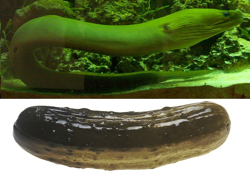Beloved eel is no moray
Dill Pickle, a large green moray eel that had fascinated and educated countless visitors to the Virginia Institute of Marine Science during the past decade, passed away in late September.
Mr. Joey Brown, curator for the small aquaria in the VIMS Visitors Center, said the eel earned the nickname “Dill Pickle” for its resemblance to the tasty gherkin. The Institute acquired Dill from a commercial dealer in New Jersey in 2003.
Dill was a favorite of guests young and old, eliciting frequent questions concerning “his” behavior and feeding habits. (Brown notes that the sexes in eels look alike, with dissection the only sure method to tell males from females.)
“People often asked why Dill appeared to be yawning or gaping,” says Brown. “That’s actually what morays do to move water and oxygen over their gills for breathing. It isn’t a threat display.”
Green morays are nocturnal predators that hunt for fish, squid, octopuses, and crabs. At VIMS, Dill’s diet consisted of a codfish fillet served up about every 2-3 days. Upon his death, Dill had grown to 4.5-feet long and weighed 7 pounds. Dill continues to serve science and the public even in the afterlife, with his remains now part of the VIMS Fish Collection.

Green morays (Gymnothorax funebris) occur in the western Atlantic from New Jersey to Brazil, including the Gulf of Mexico. Unlike most of the other specimens in the VIMS Visitors Center, green morays do not occur in Chesapeake Bay, although they are found in Virginia’s offshore waters.
Vicki Clark, Education Coordinator in the Sea Grant Marine Advisory Services program at VIMS, says there are no plans to replace Dill with another moray eel. “Our plans are to continue to focus our aquarium collections on species that occur in the Bay,” says Clark.
The VIMS Visitor Center, located in Watermen’s Hall, is a small facility that uses local marine organisms to tell the story of VIMS research. It is open for self-guided visits from 9-4:30 on weekdays, and for guided group tours during the summer months. The facility is also open on Marine Science Day, VIMS’ annual open house.




